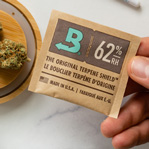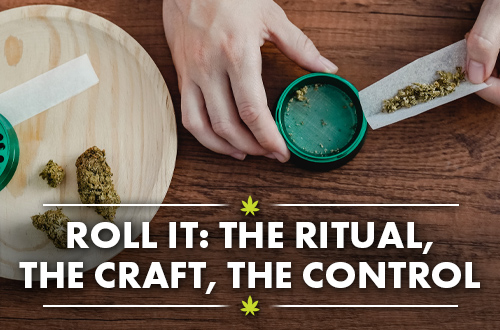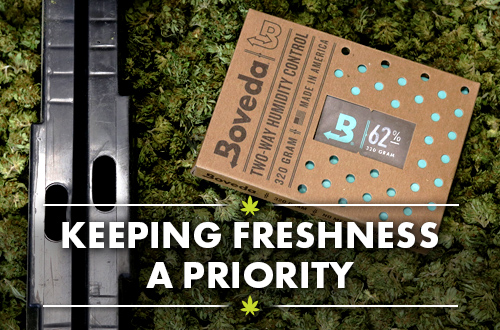Home Grow chronicles Dianna’s personal journey as a medical cannabis patient who registered and was approved by the Canadian government to grow cannabis in her home. Dianna’s experience is one grower’s point of view. Her ideas are neither the best or only proven methods for growing medicinal grade cannabis.
Cannabis—can it get too high? Definitely. Remember, cannabis grows like a weed. To cultivate strong plants, a home grower has to intervene by topping her plants. Boveda blogger Dianna Donnelly explains how she topped her girls. Being resourceful, Di used those cuttings to start her own clones. How’d it go? Read on…
Months ago after I received my home grow license and ordered my clones, I told my family about them. My niece asked what a clone was and before I could explain, my mom pointed to a tray of little calico plants that my dad had just cut and rooted. I just smiled and listened to her explain the process. How blessed I am to be in a family that sees cannabis as just another plant.
Years ago the word “clone” had a somewhat questionable feel to it. For me, that word brought images of mad scientists creating calves in Petri dishes. But the rise in popularity of growing cannabis has revamped the meaning of cloning. The practice of taking clippings from plants and rooting them has a history almost as long as horticulture itself and it all comes down to hormones.
ROOTING AROUND WITH A HOME GROW
In plants, one class of hormones is called Auxins. Auxins do many things, including trigger growth. They can also be manipulated, replicated and chemically synthesized. For instance, most gardeners buy chemically derived rooting hormone.
In my household that wee little bottle was treasured like liquid gold. I remember watching my dad clone flowering and ornamental plants to adorn our beautiful yard. He would use the rooting compound sparingly and then carefully store it away for next time. These moments are burned in my memory. I’m lucky to have witnessed his great skill. As a home grower, I can now replicate his actions. This is sustainability at its finest.
Most gardening and hardware stores carry rooting liquid, gel and now powder to ensure good coverage. Recently I learned that in a pinch some household items, like aloe vera, cinnamon or even honey, will trigger root growth in most plants.
Having watched many tutorials and videos explaining how to grow my medicine, I, like many other closet cannabis growers, have become technically educated. Because of the internet, I know exactly how to clone a cannabis plant. Because of prohibition, my fingers had never actually performed the task. When they finally did, the sense of accomplishment was overwhelming.
WHY TOP A CANNABIS PLANT
When my girls were only about a month old, I needed to top them, which is a very effective method of manipulating their growth. Anyone who’s grown tomatoes knows about topping or pinching the new growth to help the plant develop into a sturdier plant.
Now if you’re growing legally in the “Back 40,” controlling the size of your herb isn’t so important. During prohibition, isolation forced many home cultivators to grow smaller plants. Smaller is more inconspicuous.
If left to grow on their own, most cannabis plants will quickly reach great heights. The bulk of the flowers will form around the one main or apical stem. These flowers are known to be the best and densest on the plant. Perhaps from receiving the bulk of the plant’s energy. Perhaps from being closer to the light source.
Topping a cannabis plant fights this apical dominance. One stem becomes two stems of equal height and dominance. Trimming that main stalk gives some of the side branches time to catch up in their race to the sun. Topping triggers hormonal activity spurring on lower limb growth that results in a bushier, sturdier plant.
HOW TOPS CAN BECOME CLONES
Now what to do with the clippings from a cannabis plant…. Not everyone roots the clippings when they top their plants. To me, composting or trashing the clippings felt wasteful. Plus, what’s another dozen plants, eh?
In the same way that I prepared for transplant, I prepared for cloning by setting out:
- A sharp, sterilized blade
- A rooting hormone
- Peat pods that had been soaked in water and set in a small tray
- Dome crafted from cutting a 4L water bottle in half
HOME GROW CLONING TRIAL #1
Carefully with the blade in hand, I found the main stem and counted two to three nodes down, then sliced on an angle. This was harder than I thought. Either the stem was thick, the blade was dull or my confidence made for a shaky operation.
I repeated this process on the next strongest branch but used more pressure this time. I sliced through in one pass. Ha! Then I moved on to two other plants and repeated the steps.
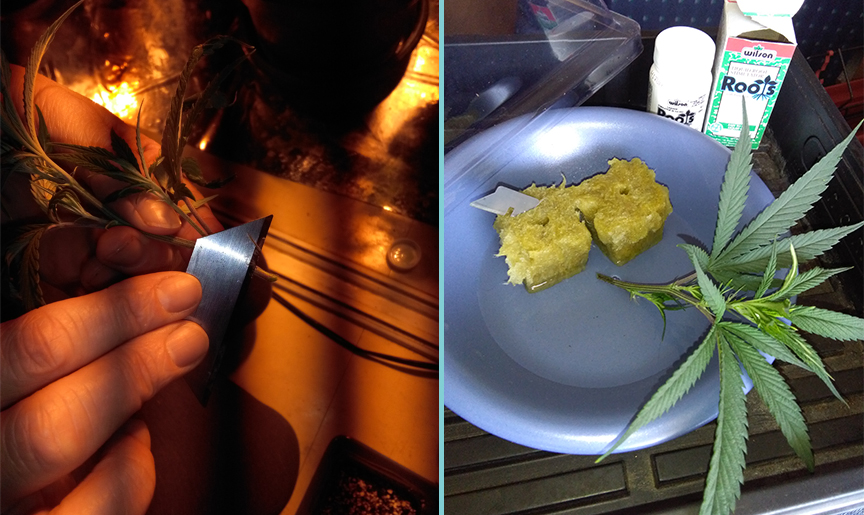
With cuttings in hand, I peeled some of the outer layers of the stems to expose more “flesh” to the rooting hormone. I dipped the exposed tips into the rooting compound and left them in there for a few moments to really coat the cuttings.
I plucked each cutting from the root compound and set each in a peat pod. When all the cuttings were transplanted, I made sure there was water on the bottom of the tray. Then I placed a water-bottle dome over top.
Every clone needs a dome to hold in moisture to feed the plants through the leaves. Until roots develop, this is the only way the plant can feed itself. I have heard some growers mist their clones often instead of using a dome.
I set the tray slightly out of direct light in the corner of my grow room closet. Over the next few days, I lifted the dome to recirculate the air and check the root status.
MY MISTAKES
In the end, only two clones survived. Here’s what I did wrong:
- My MacGyvered makeshift dome was not sufficient. In order to keep the moisture inside and easily accessible to the plant’s leaves, the dome has to fit tightly.
- I left the cuttings in the rooting hormone too long—mere minutes! I now know that rooting hormone is strong and can burn your clone instead of triggering roots.
- It’s possible that an “air embolism” occurred when I clipped the cutting, let it sit then dipped in the hormone. An air bubble could have entered the cutting and kept roots from growing.
HOME GROW CLONING TRIAL #2
A month later, I bought a tight fitting dome and tried my hand at cloning one more time. To avoid the air embolism while cutting my cannabis plant, my botanist buddy advised me to adjust my process.
- Clip the cutting off of the plant and set the end in a bowl of water. With the cut end securely under the water, carefully cut the outer skin to expose some flesh on the stalk. Then make another slice just above the first one. This ensures no air bubbles get into the plant through that cutting, which can cause an “air embolism”.
- Dip—just dip, don’t soak—the end of cutting in rooting hormone.
- Immediately set the cutting into a peat pod or other growth medium.
- Secure a tight-fitting cover over the tray.
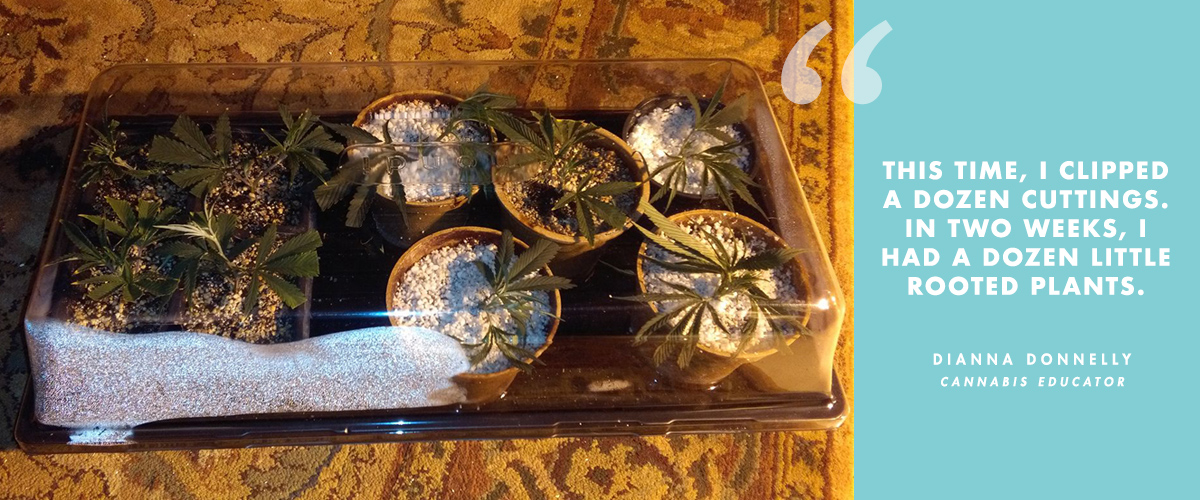
Lessons You Can Learn from My Successful Cloning Trial #2:
- Prepare all utensils beforehand.
- Re-cut cutting under water to avoid “air-embolism”.
- Moderation is key when exposing cannabis cuttings to a rooting hormone—dip, don’t soak.
- The clones need a own tight fighting dome.
- Have patience.
- Be proud of yourself. You just gave life!
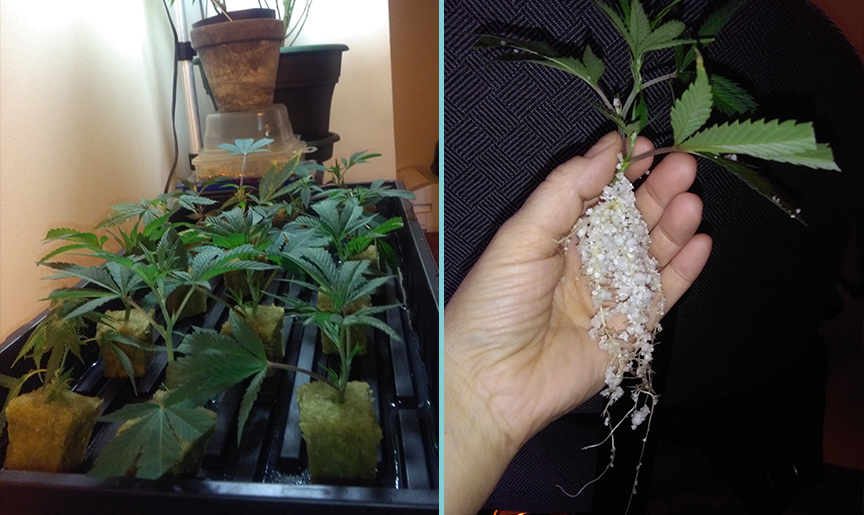

Dianna Donnelly is a cannabis educator, blogger and freelance writer living in Kingston, Ontario. She counsels new patients on the safe and effective use of medicinal cannabis and believes that with enough time, cannabis, and coconut oil she can heal the world.
Dianna Donnelly’s posts are being provided for informational purposes only; they do not constitute an endorsement or an approval by Boveda of any of the products, services or opinions of Dianna Donnelly. Boveda bears no responsibility for the accuracy, legality or content of this post or links to the posts. Contact Dianna Donnelly for answers to questions regarding her content.
Home Grow #4: Root Bound Ladies
Home Grow #6: Final Destination

